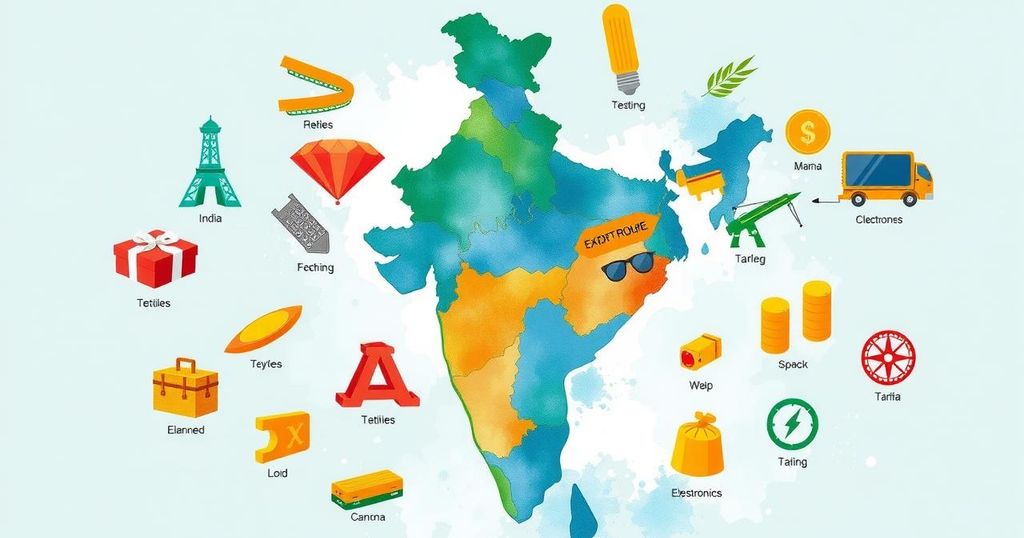Impact of Trump Tariffs on Indian Exports: An Analysis of Gains and Losses

India’s export landscape is reshaped by a 27 percent tariff on shipments to the US, affecting multiple sectors. Comparatively, India fares better than competitors like China and Vietnam, particularly in textiles and gems. While challenges remain, ongoing trade negotiations may offer relief, positioning India favorably in certain industries.
As of 2023, India is the 12th-largest exporter globally, with total exports valued at $441 billion. The introduction of a flat 27 percent tariff on Indian exports to the United States presents new challenges. However, India’s situation appears less severe compared to several key competitors, including China, which incurs a 34 percent tariff, and Vietnam, with an imposing 46 percent tariff. Bangladesh and Thailand are similarly affected with tariffs of 37 percent each, while Cambodia faces the highest at 49 percent and Sri Lanka incurs a 44 percent tariff.
In the automotive sector, the US has imposed a 25 percent tariff on imported automobiles, which could considerably impact prominent Asian manufacturers such as Toyota, Honda, and Nissan. While Indian automobile exports will be affected, they currently represent a minor portion of total auto exports to the US; passenger and commercial vehicles comprise just 0.13 percent and 3 percent, respectively. Additionally, Tata Motors may experience indirect effects on its luxury car division, Jaguar Land Rover, which relies on the US for approximately 23 percent of its revenue.
For Indian auto component exports, which make up one-third of the $21.2 billion industry total, they constitute only 2 percent of US imports, lagging behind Mexico, Canada, and China. The US represented less than 0.5 percent of India’s car exports in 2023, with Saudi Arabia, South Africa, and Mexico being the main destinations for these exports.
The textile industry in India is poised to gain from the current tariff changes since its competitors, namely Vietnam, Bangladesh, and China, are facing higher duties. The US import duties for textiles are 46 percent for Vietnam, 37 percent for Bangladesh, and 34 percent for China. In 2023, India accounted for 8 percent ($9.7 billion) of US textile imports, significantly lower than China’s 30 percent. Furthermore, textiles contribute just 2 percent to India’s GDP, in contrast to 11 percent for Bangladesh and 15 percent for Vietnam, rendering India less susceptible to sector-specific shocks.
India is also a prominent supplier of gems and jewelry to the US, comprising 12.99 percent ($11.58 billion) of total US imports in this category. With competitors like France, Italy, UAE, and Thailand holding lesser shares, this solidifies India’s leading position in the gems and jewelry market. Hence, Indian exporters might face considerable challenges due to the new tariffs relative to their global counterparts.
Agricultural exports, including basmati and non-basmati rice, buffalo meat, and wheat, will also be affected by the 27 percent tariff. Nevertheless, India might retain a pricing advantage in processed food items like pickles, pulses, and spice mixes over rivals such as China, Vietnam, Thailand, and Bangladesh. Conversely, India may find it difficult to compete with Mexico’s agricultural products, which benefit from a tax advantage under the US-Mexico-Canada Agreement (USMCA), which allows compliant goods to enter the US at tariffs as low as 0-5 percent.
In the electronics sector, India exports $14 billion worth of products to the US. The new 27 percent tariff may elevate costs; however, India still finds itself in a more favorable position than Vietnam (46 percent) and China (34 percent). Nonetheless, Mexico benefits from tariff-free access under the USMCA for compliant goods, while non-compliant items face a 25 percent tariff. Continued negotiations for a bilateral trade agreement between India and the US could potentially alleviate some of these tariff burdens, allowing Indian exports to remain competitive in specific sectors despite the challenges.
In summary, while the introduction of a 27 percent tariff on Indian exports to the United States may present significant challenges, the Indian export economy demonstrates unique strengths. Indian exporters in sectors such as textiles and gems and jewelry retain competitive positions compared to their international counterparts facing higher tariffs. Furthermore, ongoing trade negotiations hold the potential to further bolster India’s advantage in exporting to the US, particularly in electronics and automotive components. Overall, India is relatively better positioned than several key competitors, allowing for continued opportunities amidst changing trade dynamics.
Original Source: www.business-standard.com





